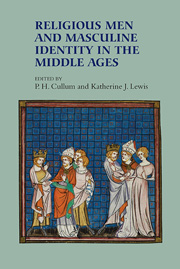Book contents
- Frontmatter
- Contents
- List of illustrations
- Contributors
- Acknowledgements
- Introduction
- From salve to weapon: Torah study, masculinity, and the Babylonian Talmud
- Gender and hierarchy: Archbishop Hincmar of Rheims (845–882) as a religious man
- The defence of clerical marriage: Religious identity and masculinity in the writings of Anglo-Norman clerics
- Writing masculinity and religious identity in Henry of Huntingdon
- ‘The quality of his virtus proved him a perfect man’: Hereward ‘the Wake’ and the representation of lay masculinity
- Episcopal authority and gender in the narratives of the First Crusade
- ‘What man are you?’: Piety and masculinity in the vitae of a Sienese craftsman and a Provençal nobleman
- ‘Imitate, too, this king in virtue, who could have done ill, and did it not’: Lay sanctity and the rewriting of Henry VI's manliness
- John of Bridlington, mitred prior and model of the mixed life
- Why men became monks in late medieval England
- Feasting not fasting: Men's devotion to the Eucharist in the later Middle Ages
- Index
‘Imitate, too, this king in virtue, who could have done ill, and did it not’: Lay sanctity and the rewriting of Henry VI's manliness
Published online by Cambridge University Press: 05 September 2013
- Frontmatter
- Contents
- List of illustrations
- Contributors
- Acknowledgements
- Introduction
- From salve to weapon: Torah study, masculinity, and the Babylonian Talmud
- Gender and hierarchy: Archbishop Hincmar of Rheims (845–882) as a religious man
- The defence of clerical marriage: Religious identity and masculinity in the writings of Anglo-Norman clerics
- Writing masculinity and religious identity in Henry of Huntingdon
- ‘The quality of his virtus proved him a perfect man’: Hereward ‘the Wake’ and the representation of lay masculinity
- Episcopal authority and gender in the narratives of the First Crusade
- ‘What man are you?’: Piety and masculinity in the vitae of a Sienese craftsman and a Provençal nobleman
- ‘Imitate, too, this king in virtue, who could have done ill, and did it not’: Lay sanctity and the rewriting of Henry VI's manliness
- John of Bridlington, mitred prior and model of the mixed life
- Why men became monks in late medieval England
- Feasting not fasting: Men's devotion to the Eucharist in the later Middle Ages
- Index
Summary
Henry VI was murdered in the Tower of London during the night of 21–22 May 1471. Earlier on 21 May Edward IV had entered London in triumph, following his victory at the Battle of Tewkesbury on 4 May. Henry's only son, Prince Edward of Westminster, had been killed at or shortly after the battle, and his death evidently sealed the fate of his father. Edward IV had Henry buried out of the way at Chertsey abbey, doubtless in part to forestall veneration of his body. Nonetheless, rumours of miracles performed at Henry's tomb began to spread and he became the focus of an extremely popular cult. This cult provides abundant evidence for the great value which medieval people continued to find in saints on the eve of the Reformation. However, initial academic approaches to it emphasised its political dimensions, exploring the ways in which devotion to Henry (in common with devotion to men such as Simon de Montfort, Thomas of Lancaster and Richard Scrope) formed an expression of opposition to the crown. Tudor interest in the cult was clearly political, involving the systematic recording of Henry's miracles as part of an attempt to have him canonised. But it is far from certain that political motives lay behind the increasing regularity with which people sought Henry VI's intercession, particularly once Richard III moved his body to a prestigious location, St George's chapel, Windsor, in August 1484.
- Type
- Chapter
- Information
- Religious Men and Masculine Identity in the Middle Ages , pp. 126 - 142Publisher: Boydell & BrewerPrint publication year: 2013

